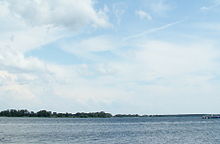Police, West Pomeranian Voivodeship
This article includes a list of general references, but it lacks sufficient corresponding inline citations. (February 2010) |
Police | |
|---|---|
 Saints Peter and Paul Gothic Church in Police-Jasienica | |
|
UTC+2 (CEST) | |
| Postal code | 72-009, 72-010, 72-011 |
| Vehicle registration | ZPL |
| Voivodeship road | |
| Website | www.police.pl |
Police (Polish:
The town is situated on the
Etymology
The name of the town comes from
History

The settlement was first mentioned in 1243.
Nearby
From the
German synthetic fuel factory
In 1937, the
During
Post–World War II

The city with the plant was captured by the Soviet Union's
Gradually, the area without the plant was given to Poland: Mścięcino on 7 September 1946, and Police with Jasienica on 19 September. On 25 February 1947 the plant also passed to Polish control. As a result, the Soviet Union allowed Polish annexations of German land west of the river Odra, beyond the border as agreed on the Potsdam Conference.[10]
The ruins of the plant still remain standing, though they are not secured and are dangerous to visit.
A large chemical plant (Zakłady Chemiczne "Police") was built in the town in 1969 and has grown since to become one of the largest in Poland. It produces mostly titanium dioxide pigments and nitrogen and phosphorus fertilizers.
Police was in the Szczecin Voivodeship from 1946 to 1998. Since 1999 the town has been part of the West Pomeranian Voivodeship.
Districts

- Police Old Town
- Mścięcino
- Jasienica
- New Town (Nowe Miasto: Osiedle Dąbrówka, Osiedle Gryfitów, Osiedle Księcia Bogusława X, Osiedle Anny Jagiellonki)
Sights

Notable buildings from the pre-WW2 era:
- the ruins of Jasienica Abbey, a former Augustinian abbey in Police-Jasienica(14th century)
- a Gothic Church in Police-Jasienica (14th/18th century)
- a Chrobry Square in The Old Town
- a Neo-GothicChurch (19th century) in Old Town
- the Police Lapidary in The Staromiejski Park in Old Town
- Tenement houses(19th century)
- Town hall (1906) (not rebuilt after WWII)
The tourist and cultural information office is localised in The Gothic Chapel in Bolesław Chrobry Square in The Old Town of Police
Geography and nature

Police is situated on the
A
Population
| Year | Pop. | ±% |
|---|---|---|
| 1740 | 1,000 | — |
| 1816 | 1,313 | +31.3% |
| 1850 | 2,500 | +90.4% |
| 1871 | 3,871 | +54.8% |
| 1880 | 4,146 | +7.1% |
| 1890 | 4,009 | −3.3% |
| 1900 | 4,415 | +10.1% |
| 1910 | 4,149 | −6.0% |
| 1925 | 4,963 | +19.6% |
| 1939 | 6,323 | +27.4% |
| 1960 | 8,894 | +40.7% |
| 1970 | 12,800 | +43.9% |
| 1980 | 24,800 | +93.8% |
| 1990 | 34,400 | +38.7% |
| 2000 | 35,000 | +1.7% |
| 2010 | 33,951 | −3.0% |
| Source: [11][3][12][13] | ||
Infrastructure

Major roads under state control connect Police to Trzebież and Nowe Warpno, No. 114; to Tanowo, No. 114; and to Szczecin over Przęsocin.
Main streets in Police include: ul. Tanowska, ul. Bankowa, ul. Grunwaldzka, ul. Kościuszki, ul. Jasienicka, ul. Dworcowa, ul. Piastów, ul. Wojska Polskiego, ul. Asfaltowa, ul. Cisowa, ul. Piłsudskiego, and ul. Wyszyńskiego.
- Railway:
- Harbours:
- Harbour
- Harbour
- Airport in Szczecin-Goleniów "Solidarność" Airport)
- Public transport:
- 10 bus lines in a town. Bus communication between all districts of a town, a few villages near Police (Trzeszczyn, Tanowo, Siedlice, Leśno Górne, Pilchowo, Przęsocin, LS to Trzebież over Dębostrów, Niekłończyca and Uniemyśl) and Szczecin City.
- Taxicab
Culture and sport

- Chemik Police- football club
- KPS Chemik Police - female volleyball club
- Łarpia Sail Festival - shanty music festival - in May, periodic
- Augustinian Fair (Polish: Jarmark Augustiański) in Jasienica - at the end of August, periodic
- Police Nationwide Quarter-Marathon (Ćwierćmaraton Policki) - in October, periodic
- Police Music Days (Polish: Polickie Dni Muzyki "Cecyliada") - in October, periodic
Hospital
A clinic hospital in Police (Siedlecka Street, The New Town, Osiedle Gryfitów) is a part of The
Notable residents
- Ludwig Hollonius (1570s-1621), pastor and playwright
- Hans Modrow (1928–2023), former premier of East Germany
Major corporations
- Zakłady Chemiczne Police SA
- )
- Infrapark Police)
Twinning cities
The
 Pasewalk, Germany
Pasewalk, Germany Novyi Rozdil, Ukraine
Novyi Rozdil, Ukraine Slagelse, Denmark [15]
Slagelse, Denmark [15]
Towns near Police
- Szczecin, Poland
- Nowe Warpno, Poland
- Goleniów, Poland
- Eggesin, Germany
- Ueckermünde, Germany
- Pasewalk, Germany
See also
- Villages in Police County: Przęsocin, Kołbaskowo, Trzebież
- Szczecin Lagoon
- Wkrzanska Forest
References
- Notes
- ^ Kazimierz Rymut, Nazwy miast Polski (Names of towns of Poland), Zakład Narodowy im. Ossolińskich, 1980, pg. 189
- ISBN 3-412-01586-5: "Die deutsche Stadt Pölitz war 1260 von Barnim I. gegründet..."
- ^ a b c Thomas Gallien, Reno Stutz, Geschichtswerkstatt Rostock, Landesheimatverband Mecklenburg-Vorpommern, Landeskundlich-historisches Lexikon Mecklenburg-Vorpommern, Hinstorff, 2007, p.503
- ^ ISBN 3-17-018152-1
- ISBN 3-486-57839-1
- ^ ISBN 3-8083-1164-9
- ISBN 3-406-50276-8
- ISBN 3-406-50276-8
- ^ ISBN 978-83-906184-8-7
- ^ Michael A. Hartenstein (1997). Die Oder-Neisse-Linie: Geschichte der Aufrichtung und Anerkennung einer problematischen Grenze. Hänsel-Hohenhausen. p. 100.
- ^ Dokumentacja Geograficzna (in Polish). Vol. 3/4. Warszawa: Instytut Geografii Polskiej Akademii Nauk. 1967. p. 39.
- ^ Rocznik Statystyczny 1981, Główny Urząd Statystyczny, Warszawa 1981, Rok XLI
- ^ Stan i struktura ludności oraz ruch naturalny w przekroju terytorialnym w 2010 r. (PDF) (in Polish). Warszawa: Główny Urząd Statystyczny. 2011. p. 109. Archived from the original (PDF) on 13 November 2011.
- ^ "Miasta partnerskie" (in Polish). bip.police.pl. Retrieved 2015-01-05.
- ^ http://www.slagelse.dk/media/8605243/nordiske-venskabsbyer.pdf [bare URL PDF]


